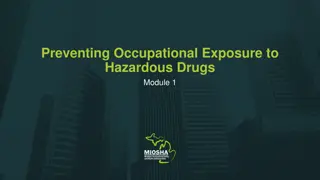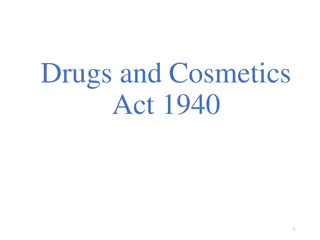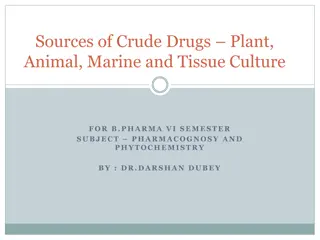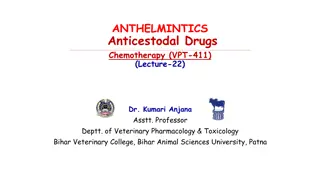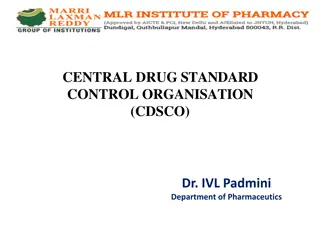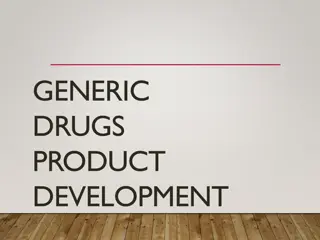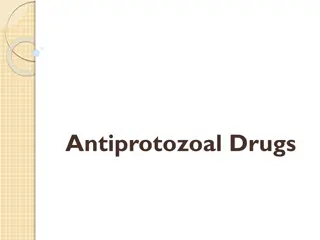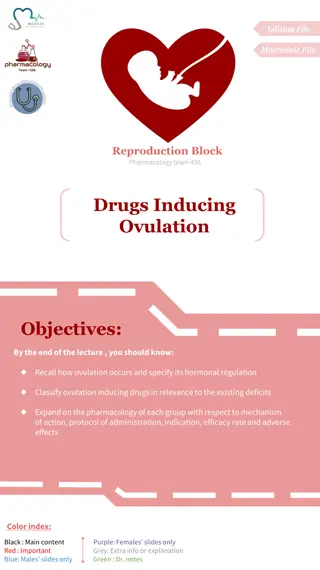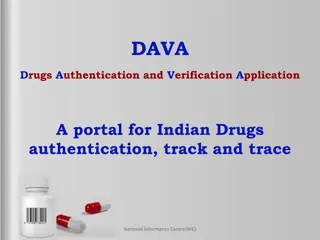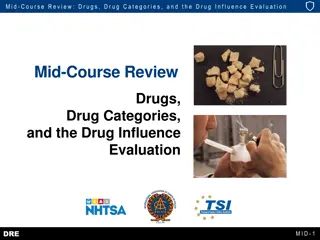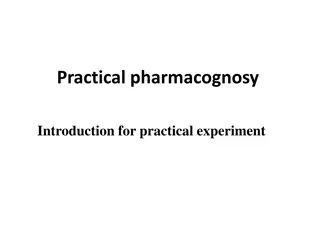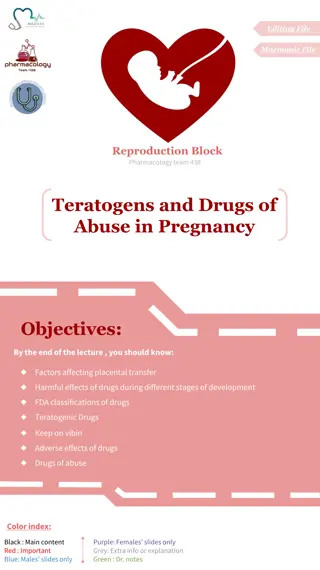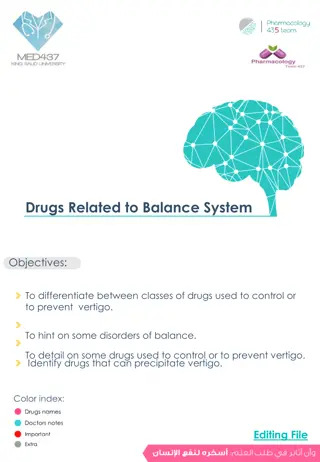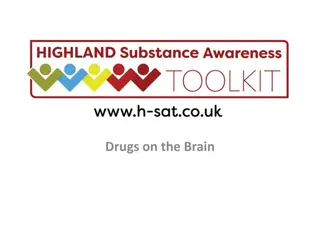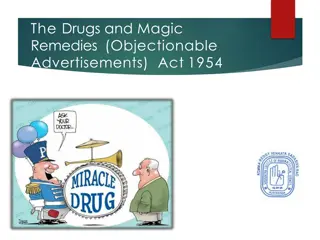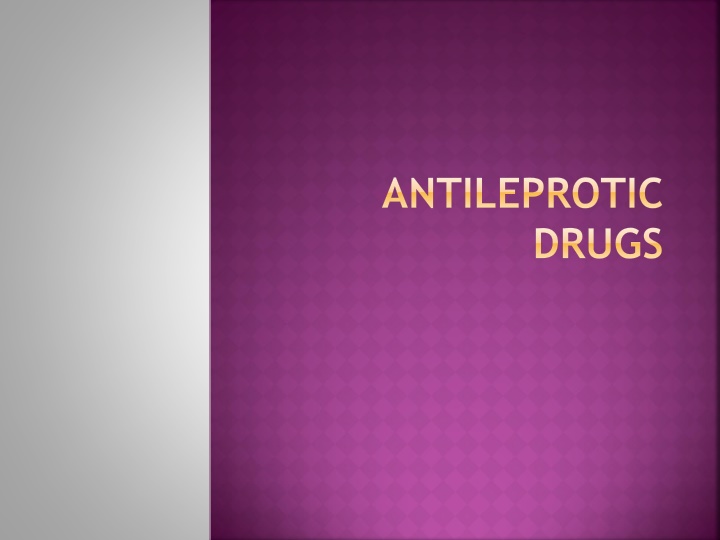
Antileprotic Drugs and Their Mechanism of Action
Explore the classification, chemistry, mechanism of action, resistance, pharmacokinetics, and therapeutic uses of antileprotic drugs, focusing on Dapsone and its role in treating leprosy, malaria, and other bacterial infections. Learn about the history of leprosy treatment, drug resistance, and the importance of multi-drug therapy. Discover how Dapsone inhibits bacterial growth and the impact of PABA interaction on its effectiveness.
Download Presentation

Please find below an Image/Link to download the presentation.
The content on the website is provided AS IS for your information and personal use only. It may not be sold, licensed, or shared on other websites without obtaining consent from the author. If you encounter any issues during the download, it is possible that the publisher has removed the file from their server.
You are allowed to download the files provided on this website for personal or commercial use, subject to the condition that they are used lawfully. All files are the property of their respective owners.
The content on the website is provided AS IS for your information and personal use only. It may not be sold, licensed, or shared on other websites without obtaining consent from the author.
E N D
Presentation Transcript
ANTILEPROTIC DRUGS
INTRODUCTION Leprosy, caused by mycobacterium leprae, has been considered incurable since ages and bears a social stigma. Due to availability of effective antileprotic drugs now, it is entirely curable, but deformities already incurred may not reverse.
CLASSIFICATION OF DRUGS Sulfone Dapsone 2. Phenazine Derivatives Clofazimine 3. Antitubercular Drugs Rifampin Ethionamide 1.
CONTINUE 4. Other Antibiotics Ofloxacin Minocycline Clarithromycin
DAPSONE It is diamino diphenyl sulfone (DDS), the simplest, oldest, cheapest, most active and most commonly used member of it is class. All other sulfones are converted in the body to DDS, many have been used, but none is superior. It is available in 25, 50, 100mg tabs.
MECHANISM OF ACTION Inhibition of PABA incorporation into folic acid. It is antibacterial action is antagonized by PABA. It is leprostatic at low concentrations, and at relatively higher concentrations arrests the growth of many other bacteria sensitive to sulfonamides.
RESISTANCE Dapsone resistance among M. Leprae, first noted in 1964, has spread and has necessitated the use of multi-drug therapy (MDT).
PHARMACOKINETICS Dapsone is completely absorbed after oral administration and is widely distributed in the body. Dapsone is more concentrated in the skin, muscle, liver and in the kidney. Metabolites are excreted in bile and reabsorbed from the intestine. The plasma half life of dapsone is variable. Elimination takes 1-2 weeks longer.
THERAPEUTIC USES Leprosy Chloroquine resistant malaria (in combination with Pyrimethamine) Other bacteria's who are sensitive to sulfonamides.
ADVERSE EFFECTS Mild haemolytic anemia Nausea Anorexia Headache Fever Mental symptoms Allergic rashes Photo toxicity Hepatitis
CONTRAINDICATIONS Hypersensitivity Sever anemia (less than 7 Hb) G6PD
CLOFAZIMINE It is a dye with leprostatic and anti- inflammatory properties, acts probably by interfering with template function of DNA in M. Leprae. When used alone, resistance to clofazimine develops in 1-3 years. Clofazimine is orally active (40-70% absorbed).
CONTINUE The half life of Clofazimine is 70 days, so that intermittent therapy is possible. Clofazimine is used as component of multi- drug therapy of leprosy. Because of it is anti-inflammatory property, it is valuable in lepra reactions. Occasionally, it is used as a component of MDT.
CONTINUE Clofazimine is available in 50, 100mg capsules for different brand names like clofozine, hansepran.
ADVERSE EFFECTS Reddish black discoloration of skin. Discoloration of hair Dryness and itching of skin Acne Photo toxicity Conjuctival pigmentation
CONTINUE Loose stool Nausea Abdominal pain Anorexia Weight loss
CAUTION Clofazimine is to be avoided during early pregnancy and in patients with liver or kidney damage.
RIFAMPIN It is important antitubercular drug and bactericidal to M. Leprae. Upto 99.999% M. Leprae are killed in 3-7 days, however it is not satisfactory if used alone, some bacilli persist even after prolonged treatment- resistance develops. It has been included in the multi drug therapy of leprosy.
CONTINUE The 600mg monthly dose used in leprosy is relatively non-toxic and does not induce metabolism of other drugs. It should not be given to patients with hepatic or renal dysfunction.
ETHIONAMIDE Ethionamide is a antitubercular drug that has significant antileprotic activity, but causes Hepatotoxicity in 10% patients. It has been used as an alternative to Clofazimine but other substitutes are preferred. It should be used 250mg per day only when absolutely necessary.
OTHER ANTIBIOTICS Ofloxacin Pefloxacin Gatifloxacin Sparfloxacin Minocycline Clarithromycin
OFLOXACIN Many trials have evaluated ofloxacin as a component of MDT and found it to hasten the bacteriological and clinical response. Over 99.9% bacilli were found to be killed by 22 daily doses of ofloxacin monotherapy. It is used in case of rifampin cannot used or to shorten the duration of treatment. Dose: 400mg per day.
MINOCYCLINE Minocycline has high lipophilicity and active against M. Leprae. A dose 100mg per day produces peak blood levels that exceed maximum concentration. It is antibacterial activity is less than the rifampin. It is included multiple Drug Therapy.
TREATMENT OF LEPROSY Leprosy is a chronic granulomatous infection caused by mycobacterium Leprae, primarily affecting skin, mucous membrane and nerves. It is more prevalent among the lowest socio- economic strata. Many patients exploit it for begging and donot come forward for treatment.
CONTINUE Two polar types- lepromatous (LL), and tuberculoid (TT) with four intermediate forms- borderline (BB), borderline lepromatous (BL), borderline tuberculoid (BT) and indeterminate (I) of the disease are recognized.
CLASSIFICATION OF LEPROSY For operational purposes, leprosy has been divided into: Paucibacillary leprosy (PBL): Non- infectious, this includes TT, BT, I. Multibacillary leprosy (MBL): infectious and this includes LL, BL, BB. 1. 2.
MULTIPLE DRUG THERAPY OF LEPROSY Multibacillary Rifampin 600mg once a month, supervised. Dapsone 100mg daily, self administered. Clofazimine 300mg once a month supervised, and 50mg daily self administered. The duration is 12 months or it can be 2 years. 1.
CONTINUE 2. Paucibacillary Rifampin 600mg once a month supervised. Dapsone 100mg self administered. Dapsone 100mg daily. the duration is 6 months.
RIFAMPIN CASE STUDY ID/CC: A 19 year old military recruit comes to his medical officer complaining of red urine and orange colored staining of his T-shirt, he also complains that every time he takes rifampin, he feels as if he has the flu. HPI: He underwent a routine physical exam and laboratory tests prior to joining the military camp and was started on rifampin at that time for meningococcal carrier state.
CONTINUE PE: VS: normal, PE: muscular male in no acute distress, no jaundice, hepatomegaly, spider angiomas or parotid enlargement; nonpruitic maculopapular rash on chest and petechial hemorrhages on limbs. Labs: AST and ALT moderately increased. UA: Proteinuria. CBC: thrombocytopenia. Imaging: CXR is normal
CONTINUE Treatment: Switch to Ceftriaxone or ciprofloxacin for eradication of meningococcal carrier state. Discussion: Rifampin is an antituberculous drug that acts by inhibiting DNA-dependant RNA polymerase. One of its major drawbacks is the rapid development of resistance if used alone. Other side-effects include discoloration of urine and sweat with a yellowish orange, hepatic damage, skin rash, thrombocytopenia, and increased metabolism of anti-coagulants and HIV protease inhibitors.
CONTINUE THANK YOU

